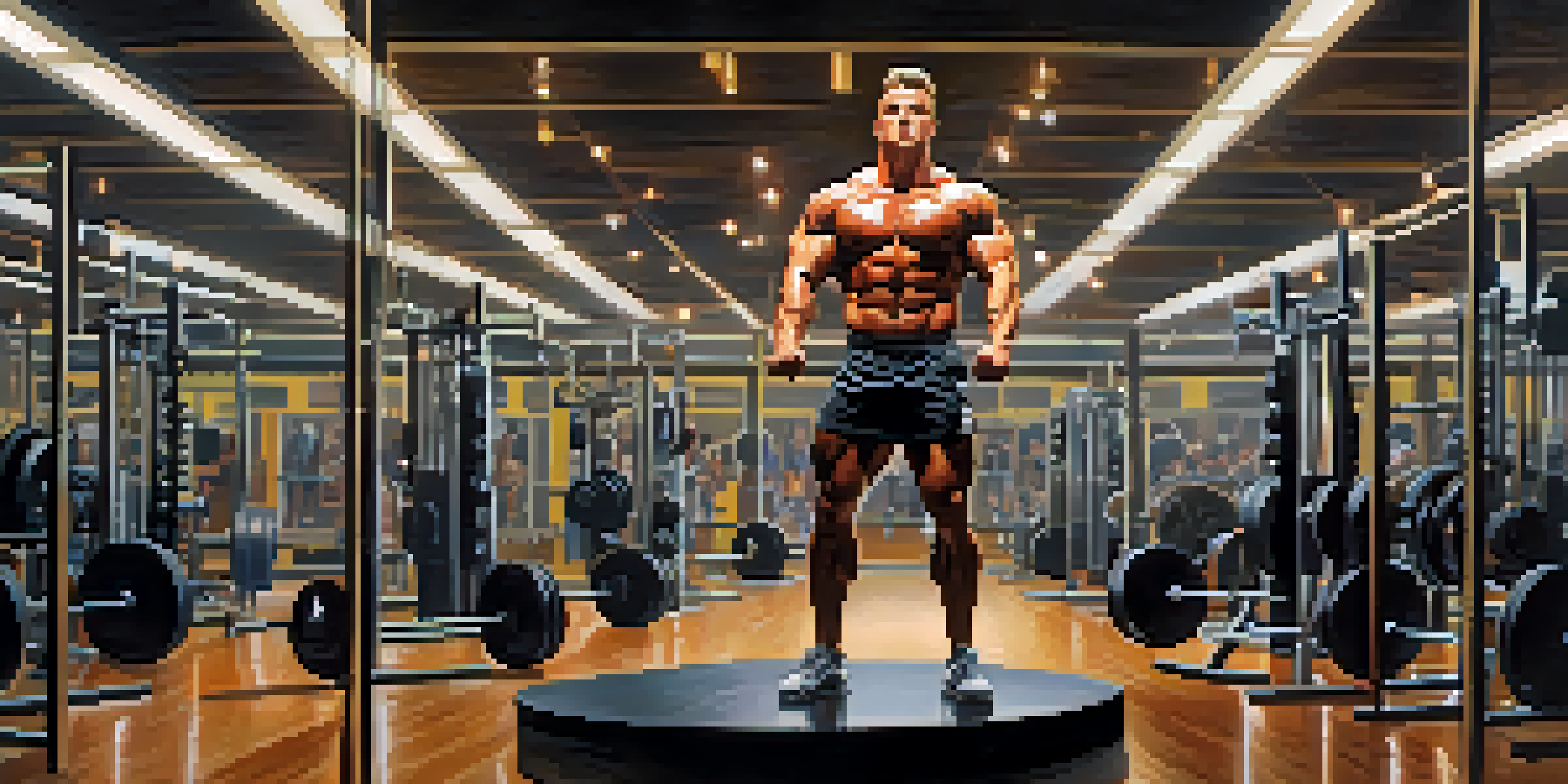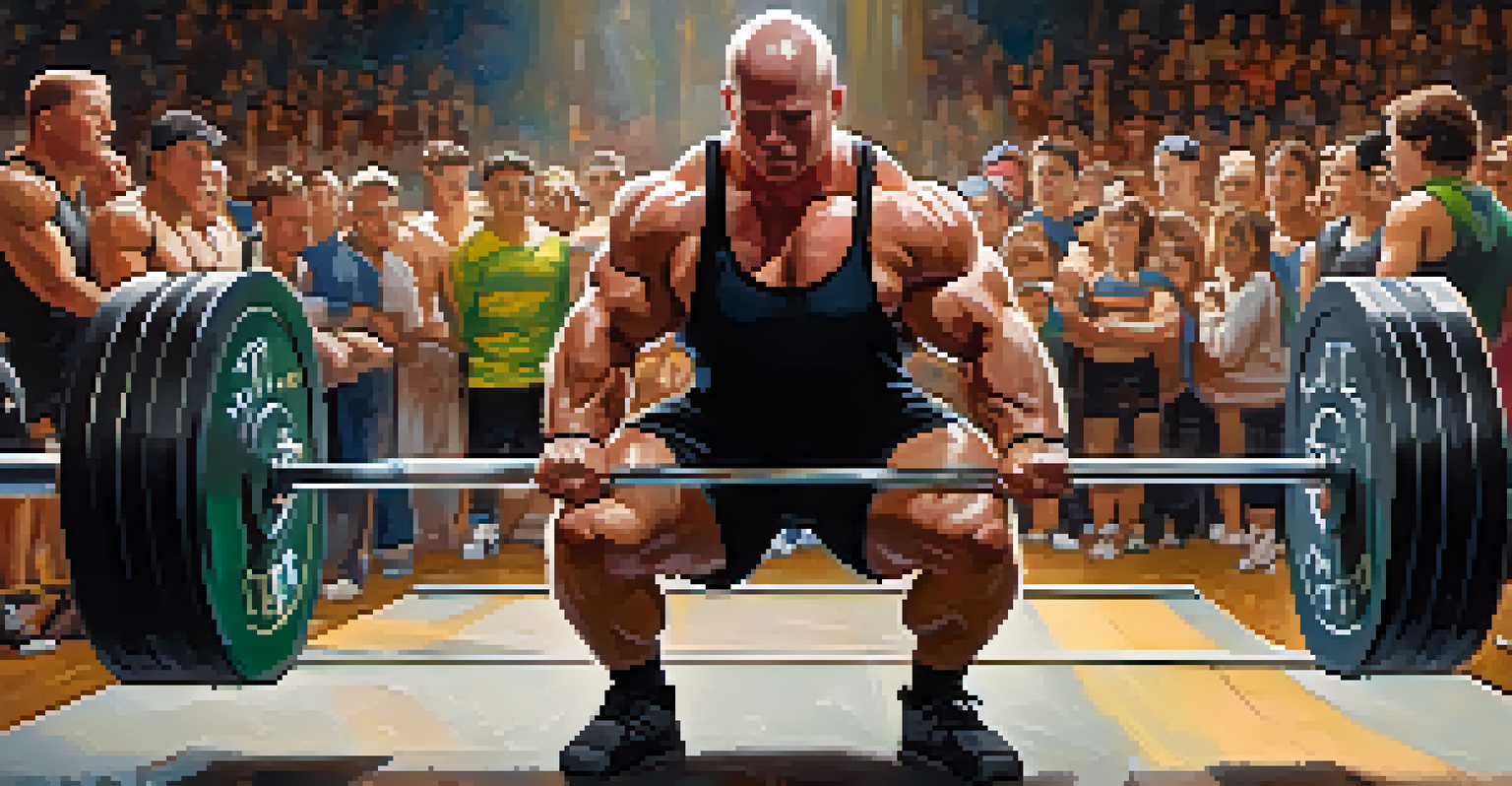Bodybuilding vs. Powerlifting: A Historical Comparison

The Origins: Where Bodybuilding and Powerlifting Began
Bodybuilding and powerlifting, while both focused on strength, have distinct origins. Bodybuilding traces its roots back to the late 19th century, influenced by strongmen who showcased their physiques in vaudeville shows. Powerlifting, on the other hand, emerged in the mid-20th century, evolving from Olympic weightlifting competitions as athletes sought to specialize in raw strength.
Strength does not come from physical capacity. It comes from an indomitable will.
As these two sports developed, they attracted different communities and cultures. Bodybuilders often focused on aesthetics and symmetry, leading to competitions that judged physical appearance as much as strength. Conversely, powerlifting competitions emphasized pure strength in three main lifts: the squat, bench press, and deadlift, creating a different kind of camaraderie among lifters.
Understanding these origins helps us appreciate the disciplines' respective philosophies. While bodybuilders aim to build a visually appealing physique, powerlifters strive to lift the heaviest weights possible. This fundamental difference in purpose shapes how athletes train, compete, and ultimately view their achievements.
The Training Regimens: Sculpting vs. Lifting
Training for bodybuilding and powerlifting involves different methodologies that cater to their specific goals. Bodybuilders typically engage in a split routine, focusing on individual muscle groups each day to promote hypertrophy, or muscle growth. This often includes higher repetitions and moderate weights to achieve the desired aesthetic.

In contrast, powerlifting training is centered around maximizing strength in the three core lifts. Powerlifters usually follow a program that emphasizes lower repetitions and heavier weights, with a focus on building explosive power and technique. This approach not only develops muscle but also conditions the body for handling significant loads.
Distinct Origins of Two Sports
Bodybuilding focuses on aesthetics and symmetry, while powerlifting emphasizes raw strength through specific lifts.
Both training regimens require discipline and dedication, yet they highlight different aspects of fitness. While bodybuilders may spend hours perfecting their form and symmetry, powerlifters concentrate on their lifting technique and overall strength progression. This divergence underscores how each discipline prioritizes unique elements of physical fitness.
Nutrition: Fueling the Body for Performance
Nutrition plays a crucial role in both bodybuilding and powerlifting, although the focus may vary significantly. Bodybuilders often follow strict diets designed to cut fat while maintaining muscle mass, incorporating high protein intake and specific macronutrient ratios. Their nutritional strategies aim to optimize body composition for competition.
Success usually comes to those who are too busy to be looking for it.
Powerlifters, on the other hand, typically prioritize caloric intake to support their lifting goals. They may consume higher amounts of carbohydrates and fats to fuel intense training sessions and recovery. The emphasis here is on performance rather than aesthetics, which can lead to different body compositions.
Both approaches demonstrate the importance of nutrition in achieving athletic success. While bodybuilders may count every calorie to sculpt their physiques, powerlifters focus on eating enough to support their strength gains. This distinction highlights how dietary needs are influenced by the goals of each sport.
Competitions: Showcasing Strength and Aesthetics
Competitions in bodybuilding and powerlifting showcase the athletes' dedication and hard work, but they do so in markedly different ways. In bodybuilding, competitors are judged on their physique, including muscle size, symmetry, and overall presentation. Events often feature a series of poses that emphasize their sculpted bodies under bright lights.
Powerlifting competitions, however, focus exclusively on performance. Athletes lift before a panel of judges, who assess their technique and the weight lifted. Each lifter has three attempts at each of the three lifts, and their total score is the sum of their best attempts, making it a straightforward measure of strength.
Different Training Methodologies
Bodybuilders utilize higher repetitions for muscle growth, whereas powerlifters concentrate on lower repetitions to maximize strength.
These distinct competition formats reveal the differing values of each sport. Bodybuilding celebrates the artistry of the human form, while powerlifting champions raw strength and determination. This difference creates separate communities and fan bases that appreciate the unique qualities of each discipline.
The Community: Support, Rivalry, and Growth
The bodybuilding and powerlifting communities both foster support and camaraderie among their members, yet they often express it differently. Bodybuilders typically bond over shared experiences in physique preparation and the discipline required to compete. This often leads to a more communal atmosphere during training and competitions, where encouragement and feedback are prevalent.
In the powerlifting world, the environment can be intensely competitive, but there's still a strong sense of support. Lifters often cheer for each other during events, regardless of whether they're on the same team. This blend of rivalry and encouragement cultivates a unique community that thrives on mutual respect and shared goals.
Ultimately, both communities play a vital role in the athletes' journeys. They provide a platform for sharing knowledge, experiences, and motivation. Whether through social media, local gyms, or competitions, these networks help individuals grow in their respective disciplines.
Cultural Impact: Shaping Fitness Trends
Bodybuilding and powerlifting have significantly influenced fitness trends over the decades. Bodybuilding has long been associated with the 'ideal' physique, inspiring countless fitness enthusiasts to aspire to a sculpted look. Iconic figures like Arnold Schwarzenegger and Ronnie Coleman have popularized the sport, making it a prominent part of fitness culture.
Powerlifting has also gained traction, especially with the rise of social media. Athletes like Ed Coan and more recently, Hafthor Bjornsson, have brought attention to the sport, showcasing the sheer strength required for competition. This visibility has encouraged more people to explore powerlifting as a serious athletic pursuit.
Unique Community Dynamics
Both bodybuilding and powerlifting foster support and camaraderie, but they express it through shared experiences or intense competition.
Both sports have contributed to a broader understanding of fitness. They've opened doors for various training styles and have encouraged individuals to find their unique strengths. The cultural impact of bodybuilding and powerlifting continues to shape how we perceive strength and fitness today.
The Future: Evolving Practices and Trends
As the fitness industry evolves, both bodybuilding and powerlifting are adapting to new trends and practices. For bodybuilders, there's a growing emphasis on health and longevity, with many athletes focusing on sustainable training and nutrition practices. This shift aims to promote a balanced approach to fitness while still achieving aesthetic goals.
Powerlifting is also seeing changes, with more emphasis on inclusivity and accessibility. Organizations are working to create environments where lifters of all backgrounds and abilities can participate and compete. This evolution is helping to break down barriers and expand the sport's reach.

Looking ahead, both disciplines will likely continue to influence each other and the fitness landscape as a whole. The blending of aesthetics and strength training may give rise to new hybrid training styles, encouraging athletes to explore the best of both worlds. The future promises exciting developments for both bodybuilding and powerlifting enthusiasts.